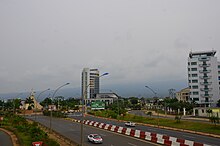 Malabo, largest city in Equatorial Guinea | |
| Currency | Communauté Financière Africaine franc (XAF) |
|---|---|
| calendar year | |
Trade organizations | AU, AfCFTA, ECCAS, UDEAC, WTO (observer) |
Country group |
|
| Statistics | |
| GDP | |
| GDP rank | |
GDP growth |
|
GDP per capita | |
GDP per capita rank | |
GDP by sector | agriculture: 2.9%, industry: 51.2%, services: 44.9% (2023 est.) |
| 2.5% (2023 est.)[3] | |
Population below poverty line | 2/3 of the population (2020)[4] |
| Unemployment | 8.7% (2023)[7] |
Main industries | petroleum, fishing, saw-milling, natural gas[7] |
| External | |
| Exports | $6.2 billion (2022 est.)[7] |
Main export partners | |
| Imports | $4.297 billion (2022 est.) |
Main import partners | |
| Public finances | |
| external: $4.5 billion (2017)[7] | |
| Revenues | $3.62 billion (2022)[7] |
| Expenses | $1.512 billion (2022)[7] |
| Economic aid | none |
All values, unless otherwise stated, are in US dollars. | |
The economy of Equatorial Guinea has traditionally been dependent on commodities such as cocoa and coffee, but is now heavily dependent on petroleum due to the discovery and exploitation of significant oil reserves in the 1980s.[9] In 2017, it graduated from "Least Developed Country" status, one of six Sub-Saharan African nations that managed to do so.
However, despite the economic growth and improving infrastructure, the country has been ranked only 138th out of 188 countries on the United Nations Human Development Index in 2015 and despite its impressive GNI figure, it is still plagued by extreme poverty. After the oil price collapsed in 2014, the economy went into a free fall which put growth in a downward spiral from around 15% to −10%. Only 950,000 of 1.6 million inhabitants are citizens, giving Equatorial Guinea the largest ratio of expatriates to residents in Africa.
- ^ "World Economic Outlook Database, April 2019". IMF.org. International Monetary Fund. Retrieved 29 September 2019.
- ^ "World Bank Country and Lending Groups". datahelpdesk.worldbank.org. World Bank. Retrieved 29 September 2019.
- ^ a b c d e f "World Economic Outlook Database, October 2024". IMF.org. International Monetary Fund. Retrieved 10 November 2024.
- ^ "Equatorial Guinea".
- ^ "Human Development Index (HDI)". hdr.undp.org. HDRO (Human Development Report Office) United Nations Development Programme. Retrieved 10 November 2024.
- ^ "Inequality-adjusted Human Development Index (IHDI)". hdr.undp.org. HDRO (Human Development Report Office) United Nations Development Programme. Retrieved 11 December 2019.
- ^ a b c d e f g "Equatorial Guinea". CIA World Factbook. January 11, 2023.
- ^ "Import Partners of Equatorial Guinea". CIA World Factbook. 2012. Archived from the original on June 13, 2007. Retrieved 2013-07-28.
- ^ "Equatorial Guinea". Retrieved 29 October 2019.